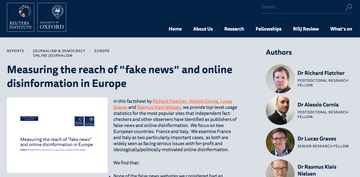
This digest has been produced in cooperation with the European Federation of Journalists (EFJ)
The production, consumption and dissemination of online disinformation has become a serious concern in many countries in recent years. As a consequence, governments, policymakers, and other stakeholders have started to take formal steps towards measuring and assessing the phenomenon. This fact sheet by the Reuters Institute for the Study of Journalism is the first evidence-based study aiming at “measuring the reach of ‘fake news’ and online disinformation in Europe” focusing on the most popular false news sites in France and Italy. These two countries have been chosen because they are facing serious issues with profit and ideologically/politically motived online disinformation, which is the typology monitored in the study and that constitutes only a subset of the wider phenomena labelled - in a quite vague ways - under the term “fake news”. For comparative purposes, the sample examined by the research includes also two prominent Russian news sites which frequently are featured in European policy discussions around disinformation, namely Russia Today (RT) and Sputnik.
The results show that the so-called fake news have a limited web reach and that the time spent on false news websites is far lower than the time spent on mainstream news websites. It is often assumed that false news have a huge impact on the people who read them. Yet the research reveals that most of the false news websites analysed had a reach of less than 1% of the online population in both countries. By comparison, the most popular news websites in France (Le Figaro) and Italy (La Repubblica) had an average monthly reach of 22.3% and 50.9%, respectively.
Despite this clear difference in terms of websites access, the level of Facebook interaction, defined as the total number of comments, shares, and reactions, generated by a small number of false news outlets matched or exceeded that produced by the most popular news brands. For instance, in France, only one false news outlet generated an average of over 11 million interactions per month - five times greater than those earned by the most established news outlets. However, overall, in both France and Italy, the total number of interactions generated by false news websites are less than those generated by the mainstream media brands. As the report correctly explains, this point should not be dismissed lightly, “given the huge gaps between news brands and false news outlets in terms of reputation and resources, as well as the vastly greater amount of online content produced by the news organisations”.
Both such trends apply to Sputnik News and Russia Today in France as well as in Italy.
Even though the results of this study confirm the evidence that false news has more limited reach than is sometime assumed, which is supported also by independent evidence-based analysis conducted in the United States, some concerns can be raised. The first refers to the primary source used: it is possible that the Facebook reach in terms of audience of the false news sites analyzed may be higher than that implied by this study, which has taken into consideration the only data that Facebook makes available, i.e. the interaction figures. Another concern refers to the use of average figures by the study: average and aggregated data may mask the reach and impact of individual news stories and the role of disinformation around specific events, issues or occasional stories which can go viral.
This report represents the first step towards providing evidence of the diffusion of false news and disinformation in Europe: much more research in the subject is needed.
Tags: Fake news and disinformation Italy FranceThe content of this article can be used according to the terms of Creative Commons: Attribution-NonCommercial 4.0 International (CC BY-NC 4.0) . To do so use the the wording "this article was originally published on the Resource Centre on Media Freedom in Europe" including a direct active link to the original article page.


